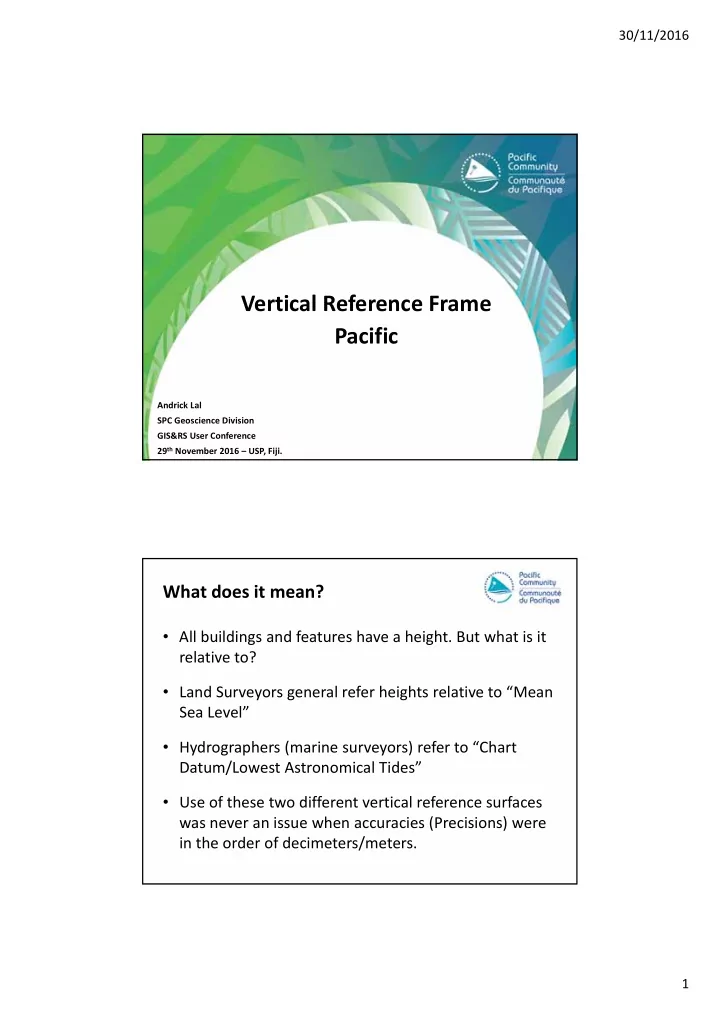

30/11/2016 Vertical Reference Frame Pacific Andrick Lal SPC Geoscience Division GIS&RS User Conference 29 th November 2016 – USP, Fiji. What does it mean? • All buildings and features have a height. But what is it relative to? • Land Surveyors general refer heights relative to “Mean Sea Level” • Hydrographers (marine surveyors) refer to “Chart Datum/Lowest Astronomical Tides” • Use of these two different vertical reference surfaces was never an issue when accuracies (Precisions) were in the order of decimeters/meters. 1
30/11/2016 Relative Approach Building 215 Post Office Geographical (latitude, longitude & height) – Locational Data & information Absolute Approach 2
30/11/2016 Introduction • One dimensional coordinate system used to define the distance of a point from a reference surface along a well defined path • Complex description because there are a number of reference surfaces and a number of well defined paths • Two types of height systems: 1. Physical – based on Earth’s gravity field and measured along the curved plumbline (e.g. orthometric heights) 2. Geometric – not based on gravity field (e.g. GNSS ellipsoidal heights) Purpose: become more aware of the different reference • surfaces and different paths Introduction • Traditionally people prefer to know their height relative to sea level (physical height surface): • Water flow for drainage systems • Height of buildings above a flooding river • Satellite positioning systems (GNSS and remote sensing) determine heights relative to the ellipsoid (geometric) • These height systems aren’t aligned, but can be connected (e.g. using geoid models) • It is important to understand how these systems are different and how data from these systems can be used together 3
30/11/2016 Earth ‐ Centered, Earth ‐ Fixed (XYZ) Conventional Z Axis Terrestrial Pole P (X,Y,Z) Earth’s Surface Zero Meridian Z Origin Y Axis (0,0,0) Center of Mass X Y Mean Equatorial Plane X Axis Dan Roman, 2007 Latitude, Longitude, Ellipsoidal Height (LLH) Z Axis (X,Y,Z) = P ( φ , λ ,h) P h Earth’s surface Zero Meridian Reference Ellipsoid Y Axis φ λ X Axis Mean Equatorial Plane Dan Roman, 2007 4
30/11/2016 Vertical Datum Global Geoid Model 5
30/11/2016 Global Geoids • Derived from analysis of satellite measurements • Long wavelength (low resolution) • Consist of spherical harmonic coefficients (SHM) • Modern GGMs to very high degree & order • Geoid, gravity & geopotential quantities can be computed from SHM • Some include surface gravity data, e.g. EGM2008 • Most are purely satellite ‐ based • Often accurate to sub ‐ decimetre Regional Approach ‐ VRF • Physical – Gravity only • Geometric – GNSS levelling • Combined or fitted – Gravity based geoids combined with GNSS ‐ levelling 6
30/11/2016 Pacific Sea Level Monitoring Project (PSLMP) The Pacific Sea Level Monitoring (PSLM), operates under the Climate and • Oceans Support Program in the Pacific (COSPPac). It is a continuation of the 20 ‐ year South Pacific Sea Level and Climate Monitoring Project (SPSLCMP) Comprises of a tide gauge network component and geodetic monitoring • component To monitor sea level over a long time period, vertical crustal movement of • the earth needs to be accounted for, to provide an absolute reading from the tide gauge Geodetic monitoring component is maintained by Geoscience Australia • Providing a long term height time series of data • Consistent, accurate, global geocentric terrestrial reference frame – ITRF2008 • Meeting accuracy requirements to match the expected sea level rise determined from over a century • previous global tide gauge measurements of 1mm/annum Pacific Sea Level Monitoring Project Tide Gauge Station 7
30/11/2016 GNSS Station (CORS) ‐ Lautoka Established in November 2002; Supported by Lautoka Lands Department • ftp://ftp.ga.gov.au/geodesy ‐ outgoing/gnss/data/ http://auscors.ga.gov.au/status/ http://www.ga.gov.au/scientific ‐ topics/positioning ‐ navigation/geodesy/gnss ‐ networks http://www.auscors.ga.gov.au/status/ 8
30/11/2016 GNSS Station (CORS) ‐ Lautoka IGS Network • http://www.igs.org/network http://www.igs.org/igsnetwork/network_by_site.php?site=laut 13 sites across the pacific 1 x permanent tide gauge at each, measuring local sea level • 1 x Constant GNSS station at each, measuring local earth movement • in an absolute coordinate system Regular levelling survey between the tide gauge and CGNSS station • allow absolute determination of the vertical height of the tide gauges that measure sea level 9
30/11/2016 Online GNSS Solutions • AUSPOS, OPUS, PositioNZ, Canadian PPP Geodetic Reference Frame ‐ Pacific The geodetic stations contribute to the implementation of the UN resolution on the Global Geodetic Reference Frame for sustainable development; Recognising the importance of positioning geospatial information to address global challenges 10
30/11/2016 Tide Gauges & Vertical Reference Frame Hydrographic Surveys/Charts ‐ UKHO Local Vertical Reference Frame A local Constant GNSS site can provide the opportunity to preform accurate baseline • measurements when the user only has 1 geodetic quality GNSS receiver available. Having observations from a CORS available will allow local Lands & Survey departments to • update their current network of survey control from a Local coordinate system onto the International Terrestrial Reference Frame [currently ITRF2008]. 11
30/11/2016 Vinaka Vaka Levu ‟ Geodetic Infrastructure underpins ALL Infrastructure” 12
Recommend
More recommend